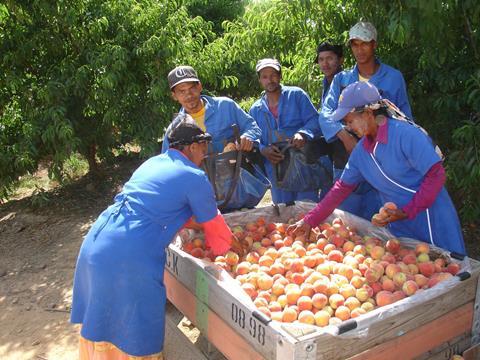
South African stonefruit growers believe they are winning the hearts and minds of UK consumers by consistently delivering product of better taste and eating quality than their competitors. This change in the fortunes of the South African industry is led by a drive to introduce better varieties that deliver on taste, as well as phasing out yesteryear’s outdated varieties.
With the start of the new export season now less than a month away, it is perhaps too early to make predictions about exactly how it will play out. There genuinely seems to be more optimism about prospects in some regions that suffered from last season’s drought, but there is still a long way to go and in some other regions growers are worried about water shortages.
The South African industry will, however, enter the season in the knowledge that its production and marketing strategies are working in the place where it matters most, namely among consumers in its major markets.
One of South Africa’s leading nectarine growers and exporters, Dutoit Agri from Ceres, believes the ability to increasingly deliver a consistent quality and eating experience is changing perceptions among consumers. Marketing director Gysbert du Toit says South Africa’s efforts to change to varieties that meet these requirements is now coming through, with the older or unwanted varieties being either phased out or sold locally.
“On average we are consistently delivering better products, have been able to extend our season, and growers in our industry are getting better at the art of only delivering the best,” says Du Toit.
The season is due to start in early October, with the last shipments around the end of March next year. This places South African stonefruit in the international markets for more than six months and allows the industry to develop a consistent message around its products with customers and consumers.
Charl Stander of Franschhoek Marketing agrees that the South African industry has convinced the retail trade in Germany, one of the most important markets for South African stonefruit next to the UK, that it is able to deliver better quality from better cultivars than the Chilean industry. “This has restored our position in this market, and coupled with our progress in the UK, we have laid the foundations for the future.”
Annelie Haumann of Stems says in selecting new varieties it is extremely important that the varieties not only meet the high standards of the market, but that they also meet the standards of sustainability for the growers back on the farm. “Varieties that are sustainable give us a good yield of the right specification fruit, which thereafter also finds favour with consumers in terms of superb eating quality and taste.”
She says Stems recognises the importance of the UK market for South African stonefruit and is working closely with receivers to build this market. “We find that as new varieties come into production they more and more fill gaps in the market, giving a more constant supply from early in the season till late. In future we will see more new varieties emerging from breeding programmes, particularly also from the local ARC programme where there is a number of very good varieties.”
Hortgro’s Jacques du Preez says the industry is pleased with its progress in Europe and the UK and has engaged with the trade to reposition itself with an increasingly different cultivar specification. “Over the past few years we have seen considerable growth, but we also know that plantings are now stabilising,” he explains. “In nectarines, exports are expected to stabilise around the four million carton mark. Peaches and plums will still see some organic growth, but we expect this to come from younger orchards and varieties that perform better.”
Plums, with around 11 million cartons being exported annually, remain the biggest South African stonefruit category. “Increasingly, I believe that South Africa’s plum category will be built around six varieties, with a number of other smaller varieties for which the marketing will be controlled,” says Stander. “They are Ruby Sun, an early red plum with yellow flesh bred by the ARC; the existing pair of Fortune and Laetetia; Ruby Star, which is another ARC-bred variety; and Angelino, which has also been around for some time.”
Du Preez says the only disappointment is apricots, where the industry is hampered by a lack of new and better varieties. Haumann agrees that there is a huge potential for exporting apricots from South Africa, provided new and exciting varieties can be introduced.
Although the new Carmingo range of blushed varieties have been introduced and are being fast-tracked by Fruits Unlimited from Paarl and the Stellenbosch-based Stargrow Fruit Marketing, the jury is still out on the future of South African apricots. The marketing of these varieties are controlled and the experience has shown that growers are not always keen to plant varieties where they cannot decide the fate of their own fruit.
Du Toit says the stonefruit producer core is fairly stable and settled, with few new entrants. “This is also contributing to enable the industry to focus on quality and taste.”
One newcomer is stART, a partnership between re:inc Innovation and seven growers from Magaliesberg in the north of the country, which produces very early peaches and nectarines. In Konstabel on the edge of the Southern Karoo, meanwhile, the group grows very late plums, which do not ripen until early April. Liezel Kriegler, director of stART, says the partnership will see major plantings in 2017, with some new varieties, including an early red flesh plum for the re:inc Innovation programme, having been planted this year.



